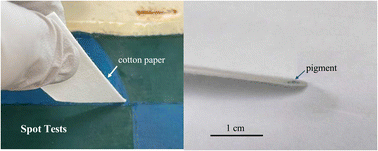Capillary action-driven surface-enhanced Raman spectroscopy (SERS) for the identification of phthalocyanine blue in modern paintings based on the BPG spot test
Abstract
A method for the extraction and accumulation of Ag nanoparticles utilizing capillary action through a piece of triangular-shaped cotton paper is reported. This method allowed the integration of SERS and the BPG spot test, which are typically employed for examining pigments on paper or in books. Malachite green oxalate was used as the model material for investigating the extent of enhancement when SERS was applied. The dynamic behavior of the Ag nanoparticles was also studied. When the cotton paper was pre-treated with malachite green oxalate, Ag nanoparticles could be extracted and accumulated on the triangular top, resulting in a dramatic SERS improvement. When malachite green oxalate (at a concentration of 10−6 M) was applied using this method, a dramatic analytical enhancement factor of approximately 3000% was obtained. Finally, the method developed in this study was successfully applied to the analysis of pigments in paintings from a university collection. The findings revealed that phthalocyanine blue was a popular pigment used in numerous paintings during the 1950s.



 Please wait while we load your content...
Please wait while we load your content...